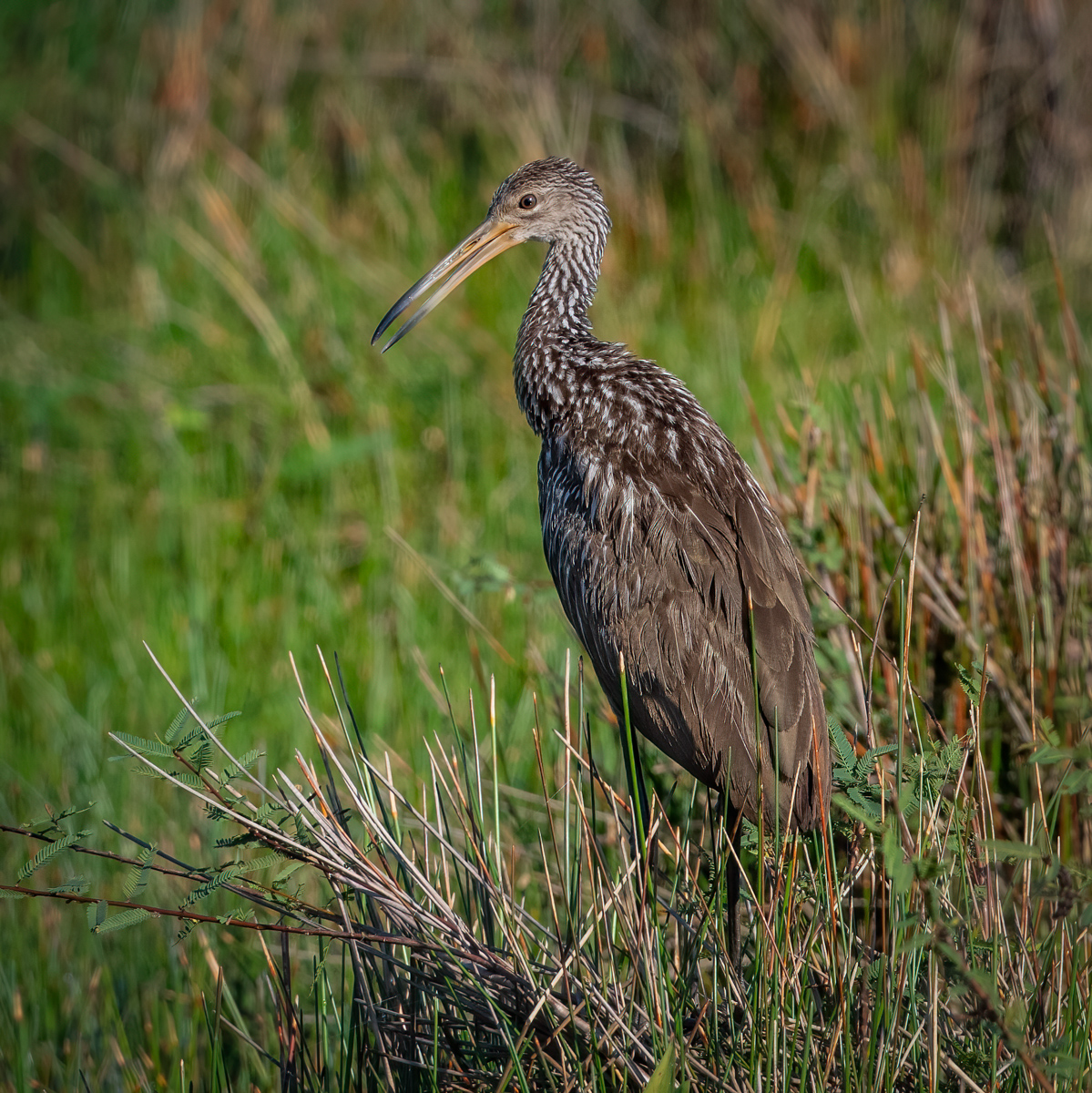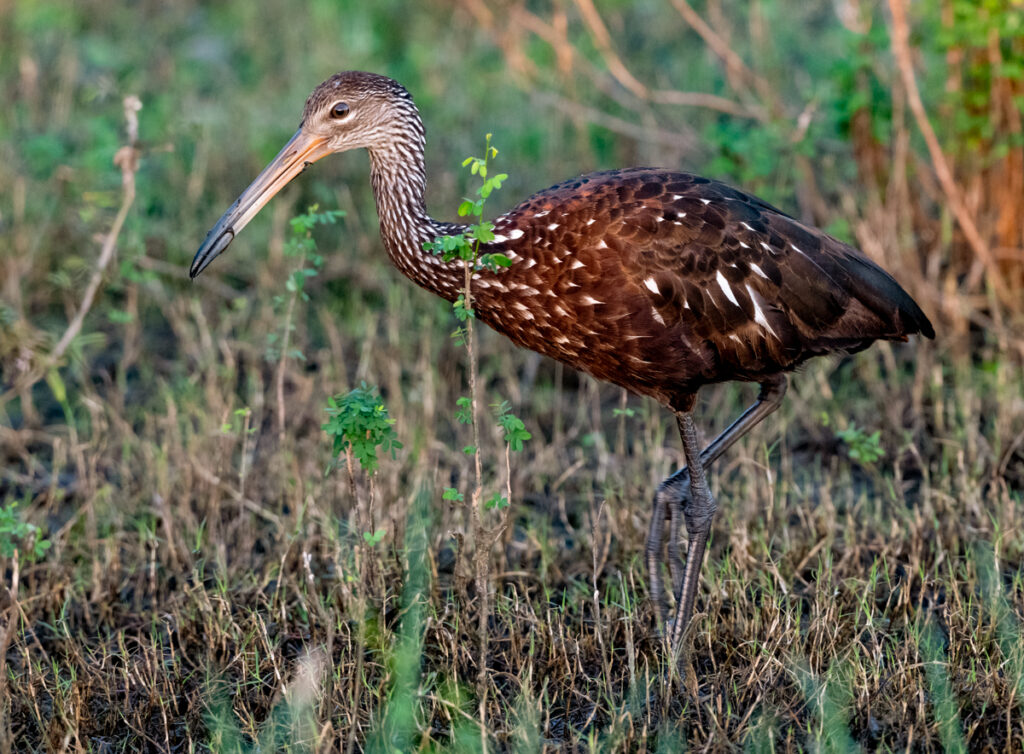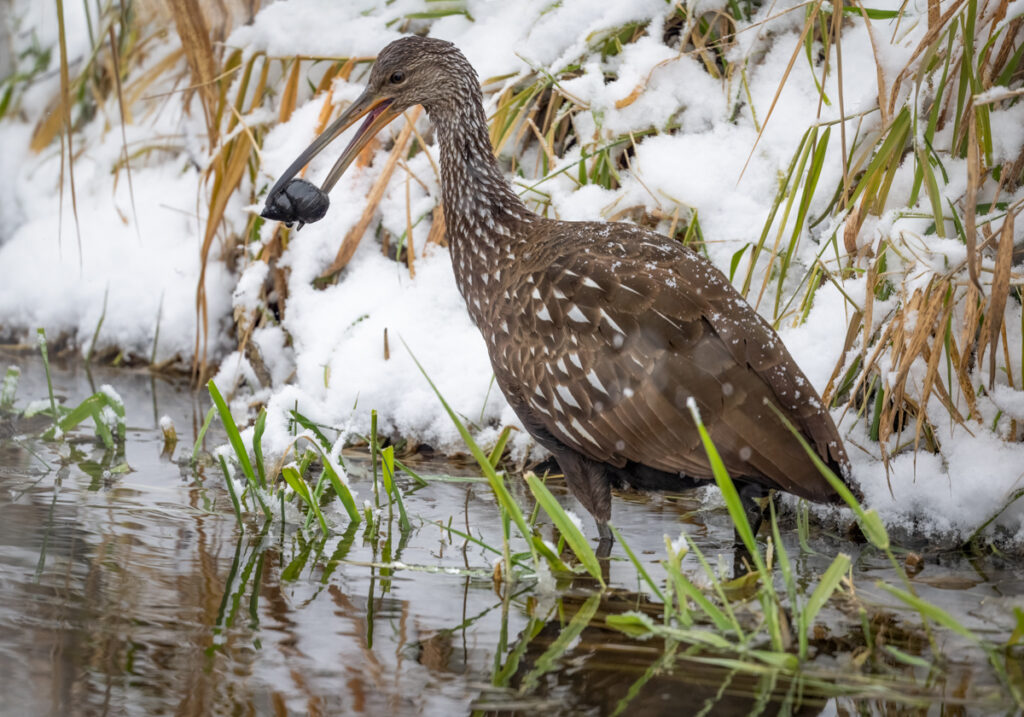
By ABA Young Birder, Malcolm O.
The 50-year-old, hundreds-of-paddles old canoe wobbled as I put my shoe in. I grabbed onto the edges and lowered myself. I adjusted my seat–a small section of sleeping pad for camping. My dad stabilized the 17-foot aluminum canoe, put his foot in, grabbed onto the sides of the boat, and pushed forward. I was familiar with the smooth thrust, and I smiled. Our bikes were in the canoe, and our plan was to paddle downriver, stash the canoe, ride back to the car, and drive back to the canoe.

As we went down this familiar stretch of the lower Grand River, wading birds were everywhere! Great Blue Herons and Great Egrets flew up out of the vegetation, and they called. The Great Blue Herons made a hoarse, coarse squawk. They sounded like dinosaurs. Long, spindly willow trees and bare shrubs on either side of the river turned into arrowhead plants (aptly named “arrowhead”) on one side, and towering cattails on the other. I suggested, “I think we should go up next to the cattail because we’ll be closer to the rails.”
My dad disagreed. “If we go farther out, we’ll be able to see over the cattail.”
We did my idea, but I quickly found out that Dad’s idea was better if we wanted to see a Black-crowned Night Heron. They often fly over that stretch of cattail.
We started seeing Green Herons–tiny, colorful, crouched birds! Their call sounded kind of like a Northern Flicker, a loud surprising kee-er! We also passed by a suspicious molting gull, double-dog-daring us to try to ID it.
All of the sudden, “Malcolm, what’s that?” my dad wondered.
I looked around frantically. I saw an island with a dead tangle at the end, sky, vegetation, and the longest river in Michigan, but no bird. My dad directed me toward the tangle, and because I was in the front of the canoe, I was 15 feet closer to the decades-old, partially submerged shrub. We slowly paddled closer.
“Malcolm, what is that?” my dad repeated. We turned the boat so that it was sideways, and I started shaking. I think it was because we were fewer than 50 feet from a dark brown wading bird we had never seen before. The bird was driving its bill into a freshwater mussel, thwack. I was excited because this seemed to be a very rare bird based on its behavior. We’d spent the last few years monitoring marsh birds on this section of river for the local Audubon Society, and we’d never seen anything like this.

We turned the boat back so we were facing the bird. “Juvenile ibis or Limpkin,” I replied nervously. After another short pause, I added, “I mean, I think it’s a Limpkin.”
After a minute of micro-adjusting the boat toward the bird, I turned around, eyes wide, and whisper-shouted, “Limpkin!” My dad and I wanted to remain quiet, but we were both thinking, “It can’t be!”
You may be wondering why we were acting this way. A Limpkin is a chocolate-brown wading bird, similar to an egret, but chunkier, and brown, of course. A Limpkin also has a long, down-curved bill. They’re usually found in Florida, the Caribbean, and south. Wading birds, especially juveniles, tend to disperse after breeding, and that summer, dispersing juvenile Limpkins had rocketed northward. If this was a Limpkin, it would be the first time the bird had been found in Michigan’s history.
My dad started taking photos of the bird with his cellphone. Of course, the Limpkin decided to show up when we didn’t have our camera OR binoculars! With bikes in the canoe that day, we hadn’t wanted to risk dumping expensive equipment in the river if things got tippy. My dad also took a grainy video or two, and watching them a few days later, I could still feel the energy. I tried to get some photos with Dad’s phone, since I was closer to the bird. I was shaking too much to get any good photos. Then, my dad sent a message to someone about the bird, and put the notice out to our local birding community.
Soon, my dad got a call. ”It’s Caleb,” he whispered, the eBird monitor for our region. For the next few minutes, I could hear my dad talking with him about ways to help others see the bird. Then, he got a text and said to me, “Curtis is on his way.” Curtis was our county’s head naturalist, whom I’d met many times before.
After 70 minutes of hanging out with the Limpkin, it slowly crept around the back side of the tangle. In other words, it started to move. We slowly canoed around the tip of the island, but for a minute, we couldn’t find it. “Wouldn’t it be so comically tragic if we never find the bird again?” My dad asked.
“Yeah, this is like Beth and the Red-cockaded,” referring to a friend of ours who had seen the only record of this woodpecker in our state, despite days of birders scouring the area. I knew it was possible to lose the Limpkin. Suddenly, I saw it! I described where it was to Dad, but as we got closer, the Limpkin flew into the arrowhead.
We met two birders in a small motorboat, who had hit the water as soon as they had seen our message on the local birding server. We asked them if they had seen the bird when it flushed. They did, but they couldn’t ID it. All of us creeped closer, with the hopes that someone else would see this bird, but the Limpkin flew farther away. We split up to try to find it. We got another brief look on the other side of the island, but still, no one else had seen it. Other birders started arriving in all manner of watercraft. Local birders Doug and Cindy were there. Caleb had a telephoto strapped to his rig, but where’s Curtis?

“Curtis just about sank on the way over here! He just made it to an island, ” Cindy said.
My dad sighed. Soon, with his boat half full of water, our county naturalist Curtis paddled wearily around the corner with a plastic grocery bag jammed into a hole in his boat. Doug got close to the arrowhead and saw movement, but no identifiable looks. During this wait, I draped my seat pad on my legs, poured water over my hands, and rubbed my hands on my face. I was on the verge of crying. We had been tracking the bird for almost two hours in the hot August sun.
Suddenly, “There it is!” Cindy yelled. Telephoto lenses sprung up, and everybody turned to see a large brown wader flying across the water. It landed in a dense tangle, similar to where we first found it, but now majestically perched for all to see.
Everybody went over to the tangle. Caleb and Curtis were paddling as fast as they could (with mild splashing), and we canoed upriver back to the launch. I looked sideways, and saw them creeping up on the Limpkin. Unfortunately, I had to drop off supplies for my school later that day, so we had to abandon our bike-canoeing plans.
Over the next several weeks, dozens of people went on rented pontoon boats to try to see this beautiful bird. We went back a few more times in the next few months and even retrieved the Giant Floater Mussel we first saw it hammering on. I remember this day because it was HOT, we waited forever, and I felt lots of different emotions. Oh yeah, and we found a first state record. So many people saw the bird over the next few months that now, according to eBird, there’s a 2% chance that you will see a Limpkin in August in our county! Just knowing that so many people saw this bird brings me joy.

Malcolm O. is eleven years old and likes hiking and birding with his family. He also enjoys canoe-camping and learning bushcraft skills. He’s passionate about making the world better for birds via native plants. For the last few years, he has participated in Christmas Bird Counts, marsh bird monitoring, and Breeding Bird Surveys. His spark bird is a Red-headed Woodpecker, and he’s trying to see 51 warblers in the U.S. by the time he is 51!


